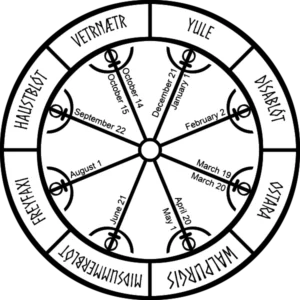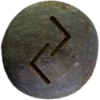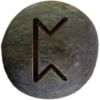Last Updated on April 9, 2025
Table of Contents



History and Mythology
The Wheel of the Year represents the cycle of seasons, marking the turning points in time that govern the natural world. In Norse tradition, this concept emphasizes the importance of balance and the rhythm of life. The year consists of eight significant points, each representing a transition between the forces of light and darkness, growth and dormancy.
At the heart of the Wheel lies the changing relationship between the sun and the earth. The winter solstice, called Yule (pronounced “YOOL”), marks the shortest day and longest night. Yule celebrates the rebirth of the sun, a time of hope and renewal. Six months later, during the summer solstice, Midsummer marks the longest day and shortest night, celebrating the sun’s full strength. Both these points reflect the eternal dance between light and dark.
Other festivals on the Wheel of the Year include the autumn and spring equinoxes, when day and night are equal. These moments emphasize balance and harmony. The equinoxes mark the transitions between planting and harvesting, reflecting humanity’s reliance on the cycles of nature for survival. Ancients would hold sacred ceremonies, asking the gods for favorable conditions during these times of change.
The Wheel also includes seasonal celebrations like the beginning of summer and the start of winter, which were times for planting, harvesting, or honoring ancestors. These celebrations not only honored the changing seasons but also expressed humanity’s deep connection with the natural world. Through these observances, people aligned themselves with the greater cosmic order, recognizing the cycles of life, death, and rebirth.
The Wheel of the Year, with its eight celebrations, served as a guide for agriculture, community, and spiritual practice, anchoring life in the eternal rhythms of the earth.
Modern and Ancient Uses
The Wheel of the Year guides both ancient and modern rituals. It follows the sun’s path and Earth’s seasonal changes. Each spoke marks a sacred festival with unique customs and focus.
In ancient times, people lit fires at solstices and equinoxes. They danced, feasted, and made offerings to gods and spirits. These acts honored land, ancestors, and the cycle of life.
Modern practitioners continue many of these traditions. They hold rituals outdoors, mark seasons with song, and share food in community. They use symbols like the sunwheel, mead, and seasonal herbs.
At Samhain (pronounced SOW-in), they remember the dead. At Beltane (pronounced BEL-tayn), they light fires for fertility and protection. Mabon, the autumn equinox, invites reflection and thanks.
The Wheel stays relevant. It keeps time in a sacred way. It links past and present. Rituals help people stay grounded in nature’s flow.
Runes Associated with the Wheel of the Year
The Elder Futhark runes Jēra and Dagaz align closely with the Pagan Wheel of the Year. ![]()
Jēra (ᛃ) symbolizes the harvest and natural cycles. It matches the celebration of Lammas, a time for gathering crops and giving thanks. The rune reflects balance and rewards from steady effort.
Dagaz (ᛞ) represents dawn, awakening, and clarity. It fits well with Yule, the winter solstice. Light returns, and hope rises. This rune marks transformation and the turning of time.
Both runes speak to nature’s rhythm. They connect people to the Earth and its constant shifts. While Jēra honors slow growth, Dagaz celebrates sudden change. These runes guide spiritual practice through the year. Each season holds lessons. The Wheel turns. Runes help us stay present.
Its Importance in Asatru
The Wheel of the Year gives structure to the spiritual lives of many Asatruar. It marks eight seasonal festivals, each tied to natural cycles and mythic meaning.
Asatruar honor the turning points—solstices, equinoxes, and cross-quarters. These moments help them align with Earth’s rhythms. Blóts mark each festival with offerings, feasting, and storytelling.
Yule, at midwinter, welcomes the return of light. Ostara, during the spring equinox, celebrates renewal. Midsummer, called Litha, honors the sun at its peak. Each holy day brings a new focus.
The Wheel ties past, present, and future. It connects Asatruar with ancestors and gods. It helps them live in harmony with land and season.

